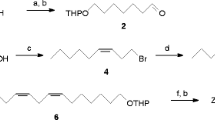Abstract
Some male carpenter bees (Xylocopa spp.) possess massive propodeal exocrine glands that produce copious quantities of multicomponent blends of lipoidal material. Some of these compounds are volatile, producing a “flowery” aroma that can be easily detected several meters downwind from a territorial male. Chemical characterization of these secretions showed them to be blends of terpenoid compounds or fatty acid derivatives. InX. varipuncta, the mixture is composed of alltrans-geranylgeraniol, alltrans-farnesal, and an isomer of 3,7, 11-trimethyl-2,7,10-dodecatrienal in an approximate 9∶6∶1 ratio. The secretion ofX. micheneri contains isopropyl oleate, (Z)-11-eicosen-1-ol, oleyl alcohol, and methyl palmitate at approximately 63∶24∶11∶1. We hypothesize that these compounds act as pheromones that aid in attracting and holding conspecific females to symbolic nonresource encounter sites where mating occurs. They also appear to have utility as chemotaxonomic markers at the subgeneric level.
Similar content being viewed by others
References
Bohlmann, F., Zeisberg, R., andKlein, E. 1975.13C-NMR-Spectren von Monoterpenen.Org. Magn. Res. 7:426–432.
Brownless, R. G., andSilverstein, R. M. 1968. A micro-preparative gas chromatograph, and a modified carbon skeleton determinator.Anal. Chem. 40:2077–2079.
Dettner, K. 1984. Isopropyl esters as wetting agents from the defensive secretions of the rove beetleCoprophilus striatulus F. (Coleoptera: Staphylinidae).Insect Kochern. 14:383–390.
Frankie, G.W., andVinson, S.B. 1977. Scent marking of passion flowers in Texas by females ofXylocopa virginica texana (Hymenoptera: Anthophoridae).J. Kans. Entomol. Soc. 50:613–625.
Gerling, D., Orion, T., andOvadia, M. 1979. Morphology, histochemistry and ultrastructure of the yellow glands ofXylocopa pubescens Spinola (Hymenoptera: Anthophoridae).Int. J. Insect Morphol. Embryol. 8:123–134.
Gerling, D., Hurd, P.D., andHefetz, A. 1983. Comparative behavioral biology of two Middle East species of carpenter bees (Xylocopa Latreille) (Hymenoptera: Apoidea).Smithson. Contrb. Zool. 369:1–33.
Hefetz, A. 1983. Function of secretion of manibular gland of male in territorial behavior ofXylocopa sulcatipes (Hymenoptera: Anthophoridae).J. Chem. Ecol. 9:923–931.
Hurd, P.D. 1978. Bamboo-nesting carpenter bees (genusXylocopa Latreille) of the subgenusStenoxylocopa Hurd and Moure (Hymenoptera: Anthophoridae).J. Kans. Entomol. Soc. 51:745–764.
Johnson, L.F., andJankowski, W.C. 1978. Carbon-13 NMR Spectra. R.E. Kreiger Publishing, Huntington, New York, 500 pp.
Kronenberg, S., andHefetz, A. 1984. Comparative analysis of Dufour's gland secretions of two carpenter bees (Xylocopinae: Anthophoridae) with different nesting habits.Comp. Biochem. Physiol. 796:421–425.
Marshall, L.D., andAlcock, J. 1981. The evolution of the mating system of the carpenter beeXylocopa varipuncta (Hymenoptera: Anthophoridae).J. Zool. London. 193:314–324.
VandenDool, H., andKratz, P.D. 1963. A generalization of the retention index system, including linear temperature programmed gas-liquid partition chromtography.J. Chromatogr. 11:463–471.
Vinson, S.B., Frankie, G.W., Blum, M.S., andWheeler, J. 1978. Isolation, identification and function of the Dufour's gland secretion ofXylocopa virginica texana (Hymenoptera: Anthophoridae).J. Chem. Ecol. 4:315–323.
Vinson, S.B., Frankie, G.W., andWilliams, H.J. 1986. Description of a new dorsal mesosomal gland in twoXylocopa species (Hymenoptera: Anthophoridae) from Costa Rica.J. Kans. Entomol. Soc. 59:185–189.
Wheeler, J.W., Evans, S.L., Blume, M.S., Velthuis, H.H.W., andCamargo, J.M.F. 1976. cis-2-Methyl-5-hydroxyhexanoic acid lactone in the mandibular gland secretion of a carpenter bee.Tetrahedron Lett. 45:4029–4032.
Williams, H.J., Elzen, G.W., Strand, M.R., andVinson, S.B. 1983. Chemistry of Dufour's gland secretions ofXylocopa virginica texana andXylocopa micans (Hymenoptera: Anthophoridae) —a comparison and reevaluation of previous work.Comp. Biochem. Physiol. 74B:759–761.
Williams, H.J.,Vinson, S.B., andFrankie, G.W. 1987. Chemical content of the dorsal mesosomal gland of twoXylocopa species (Hymenoptera: Anthophoridae) from Costa Rica.Comp. Biochem. Physiol. In press.
Author information
Authors and Affiliations
Additional information
Mention of a proprietary product does not constitute an endorsement or a recommendation for its use by USDA.
Rights and permissions
About this article
Cite this article
Andersen, J.F., Buchmann, S.L., Weisleder, D. et al. Identification of thoracic gland constituents from maleXylocopa spp. latreille (Hymenoptera: Anthophoridae) from arizona. J Chem Ecol 14, 1153–1162 (1988). https://doi.org/10.1007/BF01019343
Received:
Accepted:
Issue Date:
DOI: https://doi.org/10.1007/BF01019343




